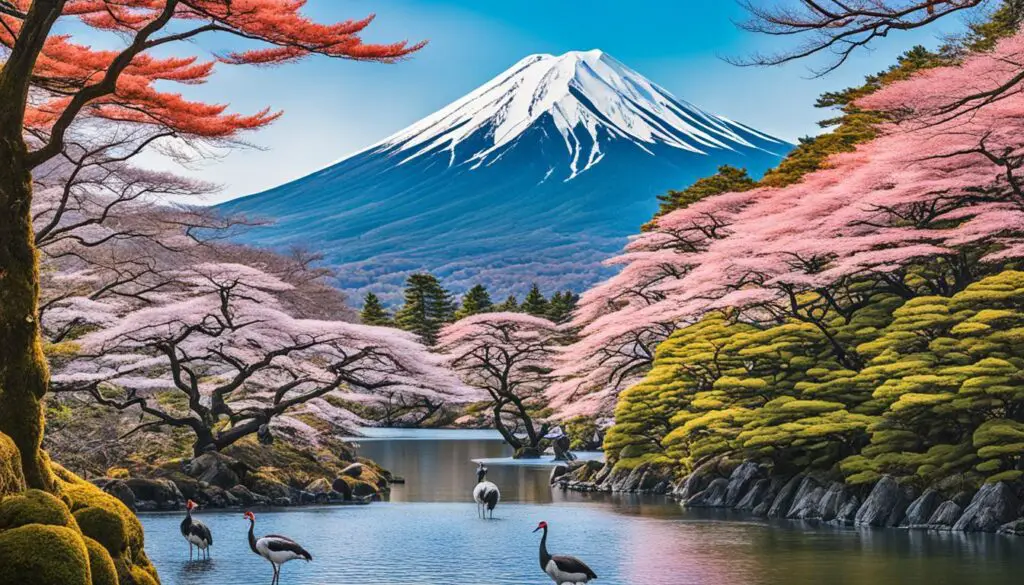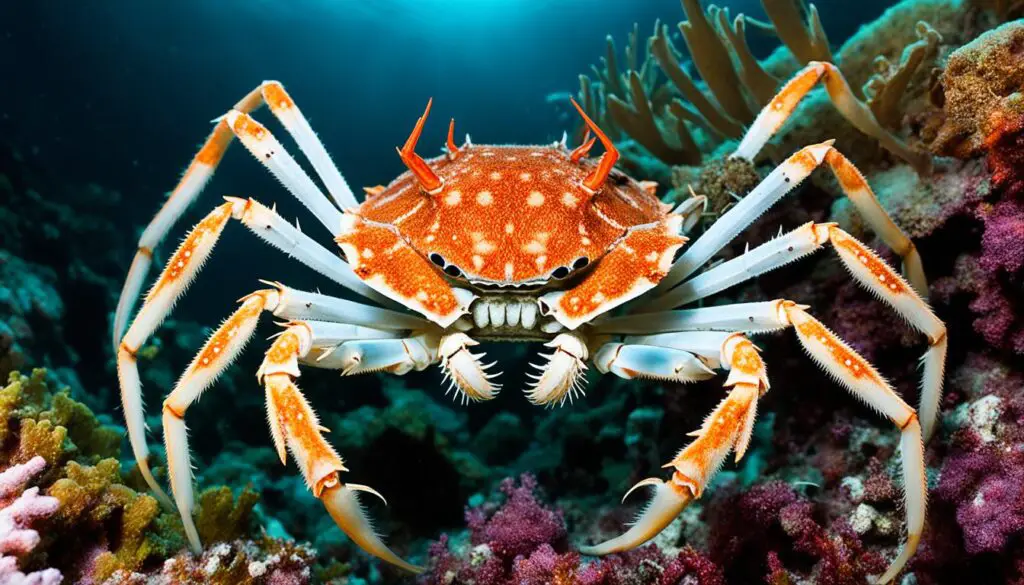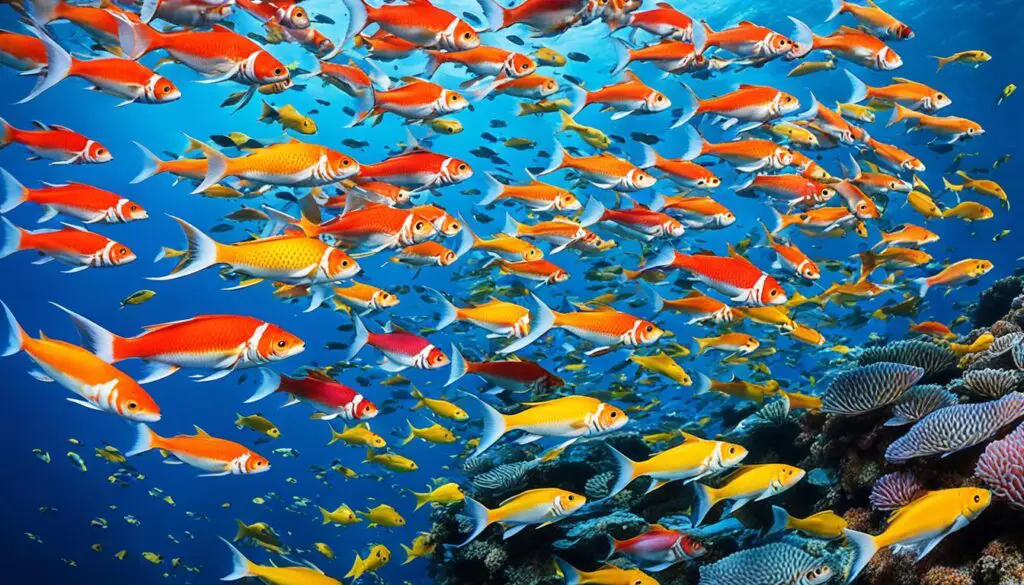Did you know that Japan is home to over 90,000 confirmed species of animals? From native creatures that have adapted to its unique landscapes to exotic marine life found in its coastal waters, the diversity of Japanese wildlife is truly awe-inspiring.

Key Takeaways:
- Japan boasts a remarkable variety of animals, including mammals, birds, marine creatures, fish, reptiles, amphibians, and insects.
- The iconic Japanese macaque, known for its hot spring bathing behavior, is just one of many fascinating mammals found in Japan.
- The red-crowned crane, a symbol of luck and longevity, is among the captivating bird species that call Japan home.
- Japan’s coastal waters are teeming with unique marine animals, such as the enormous Japanese spider crab and elusive giant squid.
- From the popular Japanese sea bream to the famous fugu (pufferfish), the fish of Japan are a culinary delight and a testament to its rich aquatic ecosystems.
Discover the incredible diversity and conservation efforts surrounding animals in Japan as we delve into their fascinating habitats and behaviors.
Mammals of Japan
Japan is home to a variety of fascinating mammals that contribute to the country’s rich wildlife. With diverse habitats ranging from snowy mountains to dense forests, Japan provides a suitable environment for diverse mammal species to thrive. Let’s explore some of the notable mammals that call Japan their home.
Japanese Macaque
The Japanese macaque, also known as the snow monkey, is an iconic and highly intelligent primate found in various regions of Japan. These monkeys are known for their unique behavior of bathing in hot springs to keep warm during the winter months. They live in social groups and are known for their elaborate grooming rituals, which help strengthen social bonds within the troop.
Japanese Serow
The Japanese serow is a goat-antelope native to Japan, inhabiting mountainous regions and dense forests. With a muscular build and short, stout horns, they are well-adapted to navigate steep terrains. These herbivores primarily feed on leaves, grass, and tree bark, showcasing their agility as climbers and foragers.
Japanese Raccoon Dog
The Japanese raccoon dog, also known as tanuki, is a canid species native to Japan. They have distinct physical features, resembling a combination of a raccoon and a dog. These omnivores are well-known for their mischievous nature and are often depicted in Japanese folklore. Despite their name, raccoon dogs are not closely related to raccoons or dogs and belong to the same family as foxes.
Japanese Red Fox
The Japanese red fox is a common and well-distributed mammal species in Japan. They can be found across various habitats, including forests, mountains, and even urban areas. With their stunning red fur, these foxes have a close association with Japanese folklore and are considered sacred in some regions. They are highly adaptable and can survive in diverse environments.
Japanese Dormouse
The Japanese dormouse, also known as the hazel dormouse, is a small rodent endemic to Japan. Known for their cute appearance and hibernation habits, these dormice are skilled climbers and spend the majority of their time in trees. They primarily feed on fruits, nuts, and insects, making them an essential part of the ecological balance in Japan’s forests.
To get a better understanding of these unique mammals, let’s take a look at the following table that provides a summary of their key characteristics:
| Mammal | Habitat | Diet | Notable Features |
|---|---|---|---|
| Japanese Macaque | Mountain forests and hot springs | Fruits, nuts, seeds, and insects | Bathing behavior in hot springs, social grooming |
| Japanese Serow | Mountainous regions and forests | Leaves, grass, and tree bark | Stout horns, muscular build, agile climbers |
| Japanese Raccoon Dog | Various habitats, including forests | Small mammals, birds, fruits, and plants | Raccoon-like appearance, mischievous behavior |
| Japanese Red Fox | Forests, mountains, and urban areas | Small mammals, birds, fish, fruits, and insects | Adaptable, stunning red fur |
| Japanese Dormouse | Forests and trees | Fruits, nuts, seeds, and insects | Hibernation habits, excellent climbers |
These mammals play an integral role in Japan’s ecosystem and contribute to the country’s overall biodiversity. Understanding and protecting the habitats of these unique creatures is crucial for their long-term survival.
Birds of Japan
The avian species found in Japan are diverse and include the majestic red-crowned crane, a symbol of luck and longevity in Japanese culture. Other notable birds include the Japanese quail, green pheasant, and Japanese wagtail.
Red-crowned Crane
The red-crowned crane, also known as the tancho crane, is an iconic bird in Japan. With its elegant white feathers and a red patch on the top of its head, this species is highly revered and represents good fortune and longevity. It is considered a national treasure of Japan and is protected under the country’s wildlife conservation laws.
Japanese Quail
The Japanese quail, scientifically known as Coturnix japonica, is a small bird species that is native to East Asia, including Japan. These quails are known for their distinctive plumage, with a combination of gray, brown, and white feathers. Japanese quails are popular as game birds and are also reared for their meat and eggs.
Green Pheasant
The green pheasant, also known as the Japanese pheasant or kiji in Japanese, is a large bird species endemic to Japan. It is characterized by its vibrant plumage, with males having a beautiful green neck and chest. These pheasants inhabit both forests and agricultural areas, and their distinct calls can often be heard in the rural countryside.
Japanese Wagtail
The Japanese wagtail, scientifically known as Motacilla grandis, is a species of wagtail that is native to Japan. These birds are known for their wagging tails and can often be spotted near water bodies such as rivers, ponds, and rice fields. With their black and white plumage, Japanese wagtails are not only charming but also serve as important indicators of a healthy ecosystem.
| Bird Species | Description |
|---|---|
| Red-crowned Crane | A majestic bird with white feathers and a red patch on its head. It is a symbol of luck and longevity in Japanese culture. |
| Japanese Quail | A small bird species with gray, brown, and white plumage. It is popular as a game bird and is reared for its meat and eggs. |
| Green Pheasant | A large bird with vibrant green plumage on its neck and chest. It is endemic to Japan and inhabits forests and agricultural areas. |
| Japanese Wagtail | A wagtail species known for its wagging tail and black and white plumage. It is commonly found near water bodies in Japan. |
Marine Animals of Japan
Japan’s coastal waters are home to a diverse array of marine animals, showcasing the country’s rich aquatic biodiversity. Let’s explore some of the fascinating species found in these waters.
Japanese Spider Crab
One of the most impressive marine creatures found in Japan is the Japanese spider crab (Macrocheira kaempferi). Known for its enormous size, this species holds the record for the largest leg span of any arthropod, reaching up to 5.5 meters (18 feet). These crabs can live up to a century and inhabit the depths of the Pacific Ocean, primarily around the waters of Honshu Island. Their presence is truly awe-inspiring, making encounters with them a highlight for divers and marine enthusiasts.
Giant Squid
Another enigmatic creature that roams the Japanese waters is the giant squid (Architeuthis). With lengths of up to 13 meters (43 feet), this deep-sea dweller is known for its elusive nature. Despite being the largest invertebrate on the planet, it rarely surfaces, and much of its behavior remains a mystery. Adult giant squids are known to lurk in the depths of the Pacific Ocean, where they prey on smaller fish and marine invertebrates. These captivating creatures have long intrigued scientists and continue to fascinate marine enthusiasts.

Japanese Sea Lily
The Japanese sea lily (Metacrinus rotundus) is a delicate and beautiful species that can be found in the waters surrounding Japan. With long and slender arms adorned with feathery appendages, these sedentary creatures attach themselves to the seafloor, where they filter-feed on planktonic organisms. Japanese sea lilies are known for their vibrant colors, making them a sight to behold for divers exploring the underwater wonders of Japan.
Firefly Squid
One of nature’s magical spectacles can be witnessed along the coast of Japan between March and June—the bioluminescent show put on by the firefly squid (Watasenia scintillans). These tiny cephalopods light up the ocean with their mesmerizing blue bioluminescence as they migrate to shallower waters. This natural phenomenon attracts visitors from around the world who gather to witness this ethereal display.
Here’s a table summarizing the key details of these fascinating marine animals:
| Marine Animal | Description | Location |
|---|---|---|
| Japanese Spider Crab | Enormous crab with the largest leg span of any arthropod | Primarily around the waters of Honshu Island |
| Giant Squid | The largest invertebrate on the planet, known for its elusive nature | Roaming the depths of the Pacific Ocean |
| Japanese Sea Lily | Sedentary creature with vibrant colors, attached to the seafloor | Waters surrounding Japan |
| Firefly Squid | Small cephalopod that produces mesmerizing bioluminescence | Coastal waters of Japan during migration season |
Fish of Japan
Japan is renowned for its seafood, and the waters around the country are home to a wide variety of fish species. From delicate and flavorful to exotic and prized, Japanese fish contribute to the nation’s rich culinary culture and fishing industry.
Japanese Sea Bream
The Japanese sea bream, also known as madai, is a popular fish in Japanese cuisine. With its firm and mild-flavored flesh, Japanese sea bream is a versatile ingredient, often prepared as sashimi, grilled, or in traditional dishes like chazuke.
Fugu (Pufferfish)
Famous for its potentially deadly toxins, fugu, or pufferfish, is considered a delicacy in Japan. Only licensed and highly skilled chefs are allowed to prepare and serve fugu, ensuring its safe consumption. The unique taste and texture of fugu make it a sought-after and unforgettable dining experience.

Koi
Koi, or nishikigoi, are ornamental fish that have captivated people around the world with their vibrant colors and patterns. Originating from Japan, koi are prized for their beauty and are often found in decorative ponds and gardens.
Maguro (Tuna)
Maguro, or tuna, is a staple in Japanese cuisine, valued for its rich taste and marbled texture. From maguro sashimi to maguro sushi rolls, this fish has become synonymous with Japanese cuisine and is highly sought after around the globe.
Reptiles, Amphibians, and Insects of Japan
Japan boasts an array of fascinating reptiles, amphibians, and insects within its diverse ecosystem. These unique creatures play an essential role in the country’s biodiversity. Let’s explore some notable species:
Reptiles of Japan
Habu Snake (Trimeresurus flavoviridis)
The habu snake is a venomous pit viper found in the Ryukyu Islands of Japan. Recognized for its aggressive nature and potent venom, the habu is a formidable reptile within the region.
Amphibians of Japan
Japanese Giant Salamander (Andrias japonicus)
The Japanese giant salamander is the second-largest amphibian globally and can grow up to five feet long. These ancient creatures inhabit clear, cold rivers throughout Japan, making their presence known with their impressive size.
Insects of Japan
Asian Giant Hornet (Vespa mandarinia)
The Asian giant hornet is known for its fearsome reputation as one of the largest hornets on the planet. Found throughout Japan, these aggressive insects possess a potent venomous sting, making them a force to be reckoned with.
Japanese Emperor Butterfly (Sasakia charonda)
The Japanese emperor butterfly is a magnificent species revered for its vibrant colors and graceful flight. This butterfly can be found in various regions of Japan, adding beauty to the country’s natural landscapes.
| Species | Common Names | Location |
|---|---|---|
| Habu Snake | Trimeresurus flavoviridis | Ryukyu Islands |
| Japanese Giant Salamander | Andrias japonicus | Throughout Japan |
| Asian Giant Hornet | Vespa mandarinia | Throughout Japan |
| Japanese Emperor Butterfly | Sasakia charonda | Various regions of Japan |
Conclusion
Japan’s diverse ecosystem showcases a fascinating range of animal species, making it an incredible destination for wildlife enthusiasts. From the majestic red-crowned crane to the playful Japanese macaque and curious Japanese serow, the country is home to a rich variety of mammals. Additionally, its coastal waters house extraordinary marine animals like the Japanese spider crab and mysterious giant squid.
The avian population of Japan is equally impressive, with the elegant red-crowned crane being a symbol of luck and longevity. Other birds, such as the Japanese quail and green pheasant, add to the country’s charm. Moreover, Japan’s waters teem with fish species like the prized Japanese sea bream and delectable maguro (tuna).
Not to be overlooked are the reptiles, amphibians, and insects that inhabit the Japanese landscape. From the venomous habu snake to the enigmatic Japanese emperor butterfly, these species contribute to the country’s natural heritage. Ensuring the conservation and protection of these animals and their habitats is of utmost importance for preserving Japan’s incredible biodiversity.
